Sigismund III Vasa
| Sigismund III Vasa | |
|---|---|
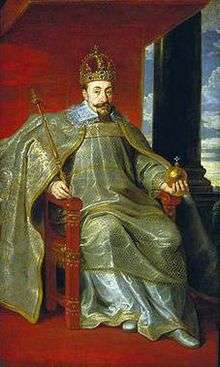 Sigismund III Vasa by Pieter Soutman | |
| King of Poland Grand Duke of Lithuania | |
| Reign | 18 September 1587 – 19 April 1632 |
| Coronation | 27 December 1587 |
| Predecessor | Anna Jagiellon and Stephen Báthory |
| Successor | Władysław IV |
| King of Sweden | |
| Reign | 17 November 1592 – 24 July 1599 |
| Coronation | 19 February 1594 |
| Predecessor | John III |
| Successor | Charles IX |
| Born |
20 June 1566 Gripsholm Castle, Sweden |
| Died |
30 April 1632 (aged 65) Warsaw, Poland |
| Burial |
4 February 1633 Wawel Cathedral, Kraków, Poland |
| Spouse |
Anna of Austria Constance of Austria |
| Issue among others... |
Władysław IV John II Casimir John Albert, Bishop of Warmia and Kraków Charles Ferdinand, Duke of Opole Alexander Charles Anna Catherine Constance, Electress Palatine |
| House | Vasa |
| Father | John III of Sweden |
| Mother | Catherine Jagellonica |
| Religion | Roman Catholicism |
| Signature |
 |
Sigismund III Vasa (also known as Sigismund III of Poland, Swedish: Sigismund, Polish: Zygmunt III Waza, Lithuanian: Žygimantas Vaza, English exonym: Sigmund; 20 June 1566 – 30 April 1632 N.S.) was King of Poland and Grand Duke of Lithuania, monarch of the united Polish–Lithuanian Commonwealth from 1587 to 1632, and King of Sweden (where he is known simply as Sigismund) from 1592 as a composite monarchy until he was deposed in 1599. He was the son of King John III of Sweden and his first wife, Catherine Jagellonica of Poland.[1]
Elected to the throne of the Polish–Lithuanian Commonwealth, Sigismund sought to create a personal union between the Commonwealth and Sweden (Polish–Swedish union), and succeeded for a time in 1592. After he had been deposed in 1599 from the Swedish throne by his uncle, Charles IX of Sweden, and a meeting of the Riksens ständer (Swedish Riksdag), he spent much of the rest of his life attempting to reclaim it.[1]
Shortly after his victory over his internal enemies, Sigismund took advantage of a period of civil unrest in Muscovy (known as the Time of Troubles) and invaded Russia, holding Moscow for two years (1610–12) and Smolensk thereafter. In 1617 the Polish–Swedish conflict, which had been interrupted by an armistice in 1611, broke out again. While Sigismund's army was also fighting Ottoman forces in Moldavia (1617–21), King Gustavus II Adolphus of Sweden (Charles IX's son) invaded Sigismund's lands, capturing Riga (1621) and seizing almost all of Polish Livonia. Sigismund, who concluded the Truce of Altmark with Sweden in 1629, never regained the Swedish crown. His Swedish wars resulted, moreover, in Poland's loss of Livonia and in a diminution of the kingdom's international prestige.[2]
Sigismund remains a highly controversial figure in Poland. His long reign coincided with the apex of the Polish–Lithuanian Commonwealth's prestige, power and economic influence. On the other hand, it was during his reign that the symptoms of decline leading to the Commonwealth's eventual demise surfaced. Popular histories, such as the books of Paweł Jasienica, tend to present Sigismund as the principal source of these destructive processes; whereas academic histories are usually not as damning of him. However, the question of whether the Commonwealth's decline was caused by Sigismund's decisions or had its roots in historical processes beyond his personal control, remains a highly debated topic.
He was commemorated in Warsaw with Sigismund's Column, commissioned by his son and successor, Władysław IV.
Early life and coronation
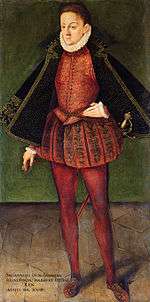
Sigismund was born on 20 June 1566 to Catherine Jagiellon and the Grand Duke John of Finland at Gripsholm. His parents, at the time, were being held prisoner by King Eric XIV, but despite the Protestant domination of Sweden young Sigismund was raised as a Roman Catholic. In 1567 Sigismund and his parents where released from prison, and in 1568 Erik XIV was deposed, and Sigismund father ascended to the throne of Sweden as King John III. From 1568 Sigismund was the crown prince of Sweden. His mother was the daughter of Polish king Sigismund I the Old and Queen Bona Sforza of Italy. In 1587 Sigismund stood for election to the Polish throne after the death of his uncle, King Stephen Bathory. He was supported by his aunt Queen Anna, Hetman Jan Zamoyski and the nobles loyal to the Zborowski family. With such a strong support from the elite families and people of influence he was duly elected ruler of the Polish–Lithuanian Commonwealth on 19 August 1587 with the blessings of the primate of Poland Stanisław Karnkowski. From that time his official name and title became: "by the grace of God, king of Poland, grand duke of Lithuania, Ruthenia, Prussia, Masovia, Samogitia, Livonia and also hereditary king of the Swedes, Goths and Wends"; the later titles being a reference to the fact that he was already the crown prince of Sweden, and thus would succeed to the Throne of Sweden upon the death of his father.
Opposition to the throne
However, as was often the case with the Polish electoral monarchy, the outcome was strongly contested by the greedy and stubborn Polish nobility who backed and supported the Archduke Maximilian III of Austria for King of Poland. Upon hearing of his election King Sigismund slipped through the clutches of the Protestants in Sweden and landed in Poland on 7 October, immediately agreeing to give up several royal privileges to the parliament (Sejm) in the hope of winning over some of his enemies and settling the disputed election. He was proclaimed by the Lesser Prussian Treasurer Jan Dulski as king on behalf of Crown Marshal Andrzej Opaliński, and after arriving in the Royal Capital City of Kraków he was crowned on 27 December at Wawel Cathedral. It seemed that the issue of who would be King of Poland had been settled when Maximilian III invaded Poland to claim the crown. Hetman Jan Zamoyski defeated Maximilian at the Battle of Byczyna and took him prisoner.[3] However, at the request of Pope Sixtus V, King Sigismund III released Maximilian, who surrendered his claim to Poland in 1589.[4] King Sigismund also tried to maintain peace with his powerful neighbor by marrying Archduchess Anne Habsburg in 1592. It was always his intention to maintain an alliance with Catholic Austria against the Protestant forces.

When his father died King Sigismund III asked the Sejm to be allowed to claim his inheritance as the rightful King of Sweden. The Poles had no objection. When he promised to respect Lutheranism as the official religion of Sweden, the Swedes also agreed. Sigismund was crowned King of Sweden in 1594.[5] He appointed his uncle, Duke Charles, to rule as regent on his behalf in Sweden while he remained in Poland, since Sweden and the Commonwealth were only in a personal union, not united in one state. However, tensions grew quickly in Sweden, as despite his pledge, King Sigismund was a devout Catholic and this made the Swedes suspicious of their new ruler. Lutheran firebrands warned that Sigismund had the ultimate goal of making Sweden Catholic again. As proof they pointed to the Union of Brest set up in 1596, which brought the Eastern Orthodox people in Ruthenia into the Catholic fold and led to the modern day Ukrainian Catholic Church.[6] The union also expressed his friendship with Catholic Austria and his support for the Catholic Reformation, particularly the Jesuits, who were spreading out to refute Protestantism and regain lost spiritual ground for Rome.
Internal and external affairs of the Commonwealth
Combating heresy and giving Poland a strong and stable government were the primary goals of Sigismund. Toward this end he moved the royal court from Kraków to Warsaw and oversaw the arrival of the Jesuits who established new schools throughout Poland and became chaplains and confessors to many families. The Catholic Church in Poland rebounded strongly during the early years of his reign. Their preaching was very well received by the public and along with their staunch defense of the faith they also reminded Poles of their crucial role as the first line of defense for Catholic Christendom against the Orthodox Russians and the Ottoman Turks. However, Sigismund often had to confront with the difficulties of ruling such a large nation and 1598 was a particularly painful year. His wife, Anna, suddenly died (he later married her sister Constance of Austria in 1605) and he experienced the outbreak of a rebellion in Sweden (known as War against Sigismund) led by his own uncle and regent who portrayed himself as the Protestant champion of Sweden fighting against their Polish Catholic monarch. King Sigismund moved against him which a combined the Swedish and Polish forces. He won some early victories but the climax came at the Battle of Stangebro in which his 8,000-strong army was defeated by 12,000 men commanded by Duke Charles. The Swedish loyalists were executed by the Protestant government and after the King returned to Poland he was declared deposed and his uncle was proclaimed King of Sweden in 1600. A number of Swedish-Polish wars resulted but the personal union was never to be recovered despite the many persistent efforts of Sigismund.[7]
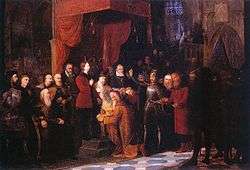
Trouble was also plentiful on the southern border where Poland was drawn into the wars of local nobles and the Austrian Habsburgs against the Muslim Tatars and Ottoman Turks. King Sigismund was anxious to help Austria and was promised territorial gains for Poland in return for his assistance. He sent in an army consisting of mercenaries from the wars in Russia to the Principality of Moldavia, but in 1620 the Polish forces were defeated and Sigismund was forced to renounce his claim to the principality. It was a setback but resulted in a negotiated peace and was no stunning victory for the Muslims, who had vowed to destroy the Polish–Lithuanian Commonwealth and in this aim they certainly failed. Almost at the same time as these troubles, and those with Sweden, Sigismund was fighting a war with the Grand Duchy of Muscovy. In the time of the Polish–Lithuanian Commonwealth it was the Poles that were a force to be reckoned with, especially their elite, heavy cavalry, most notably the Winged Hussars. While the Russians have been fighting amongst themselves in a civil war, King Sigismund saw an opportunity to invade and take power, as did Sweden though they were never firmly on one side or the other. At one point the boyars invited the son of King Sigismund, Prince Władysław, to become their new Tsar, but Sigismund disallowed it. Initially it was Sigismund who wished to gain the throne for himself and become the master of Russia and though this did not happen, the Commonwealth army was victorious in many battles and gained more territory. At one point Polish troops, under the command of the famous Hetman Stanisław Żółkiewski, captured Moscow and the Kremlin. On the downside the whole conflict meant that any lasting union between the Commonwealth and Russia was impossible and any plans concerning the final destruction of the Russian state were unsuccessful.
Sigismund's politics
Coat of arms, Polish–Lithuanian Commonwealth, and privy mark of Hieronim Wołłowicz, Grand Treasurer of Lithuania[8] (reverse, see file notation).
Many historians agreed to the fact that Sigismund considered Poland as a tool that would allow him to eventually regain the throne of Sweden. To this end he tried to strengthen his royal power and allied himself with Habsburgs and Counter-Reformation forces. His policies were opposed by many within the circles of the wealthy Polish nobility (the szlachta), most notably the chancellor Jan Zamoyski. This led to a semi-legal rebellion against the king (rokosz), known as Zebrzydowski Rebellion (1606–08), which was a response to Sigismund's attempt to introduce majority voting in place of unanimity in the Sejm. Eventually Sigismund's forces were victorious, but the rebels went unpunished. Partially in order to pacify the restless szlachta, Sigismund supported war with Muscovy (the Dimitriads, 1608–18). Although Commonwealth forces were almost constantly shuffled between wars in the East (with Muscovy), north (with Sweden) and South (with Ottomans – the Polish–Ottoman wars), Sigismund took advantage of the civil war in Russia (the Time of Troubles) and secured temporary territorial gains for the Commonwealth.[9]
While Sigismund never managed to regain the Swedish throne, his personal ambition to do so did succeed in provoking a long series of conflicts between the Commonwealth and Sweden temporarily allied with Muscovy. While the Commonwealth's Royal Parliament managed to thwart many of the plans of Sigismund (and later of his son, Władysław), the Vasa dynasty nonetheless succeeded in partially drawing the Commonwealth into the Thirty Years' War. The conflict with Sweden, combined with wars against Ottomans and Muscovy, culminated well after Sigismund's death in the series of events known as the Swedish Deluge, which ended the Golden Age of the Polish–Lithuanian Commonwealth that spanned almost a century.
During his reign Sigismund permitted the Brandenburg Hohenzollerns to inherit Ducal Prussia. This decision later greatly strengthened the Duchy and following the Commonwealth's major military defeat in the Second Northern War during the reign of Sigismund's younger son, John II Casimir, under the terms and conditions of the Treaty of Oliva, Prussia became a sovereign state and country that eventually Partition Poland together with Austria and the Russian Empire in the late 18th century.
Early conflicts with Hetman Jan Zamoyski
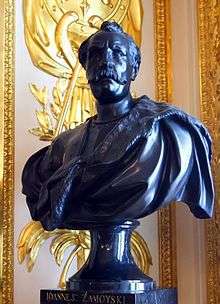

Zamoyski's bitterness and Sigismund's lust for power
The contest between the King and the Chancellor began during Sigismund's first Sejm sitting, the so-called "Pacification Sejm", which met at Warsaw in March 1589. Zamoyski presented the project of a political combination between Poland, Moscovy, and Bohemia, coupled with a suggestion that in case the present King should die without issue (a somewhat premature and gratuitous assumption in the circumstances) none but a Prince of some Slavonic stock should henceforth be eligible to the Polish throne. The extravagance of a project which could even imagine the possibility of any sort of union between Catholic Poland, Orthodox Moscovy, and semi-Protestant Bohemia struck even the majority of the Sejm with amazement. It was only explicable at all as a circuitous and clumsy attempt to traverse the Habsburg influence. The Parliament promptly rejected it, accepting instead the royal proposition of a marriage between Sigismund and the Archduchess Anne. The way had already been opened for this rapprochement with Austria by the Treaty of Bytom and Będzin (March 1589), negotiated by the Nuncio Ippolito Aldobrandini, afterwards Pope Clement VIII, whereby the Emperor resigned all his claims to the Polish Crown.[10]
At the succeeding Sejm, which assembled in March 1590, Zamoyski succeeded in persuading the deputies to exclude at any rate the Archduke Maximilian from the succession to the throne. But he had only gained his ends by skilfully frightening them with the bugbears of Austrian intrigues and Turkish threats; and his opponents, headed by the Primate Kamkowski, immediately after the Diet rose, formed a Confederation to protest against its decrees, and a second extraordinary Sejm, dominated by the enemies of Zamoyski, met at the end of the same year. It at once proceeded to reverse all the decrees of its predecessor and strike blow after blow at the Chancellor of the Crown. Thus the Grand-Hetmanship was placed in commission, the party of Maximilian was amnestied, the Zborowski family were rehabilitated and Zamoyski's friends and supporters were removed from Court. Furthermore, the chief pillars of the Catholic party in the Grand Duchy of Lithuania, the wealthy Cardinal Radziwiłł and the newly converted and highly popular Prince Ostrogski, were appointed Bishop of Kraków and Castellan of Kraków respectively. Zamoyski naturally retaliated by means of the same double-edged constitutional weapon which his opponent had used.[10]
Personal differences and attitudes
On 1 June 1592, he formed a Confederation at Jędrzejów, which was more numerously attended than the wedding feast in honour of Sigismund's young Austrian bride the Archduchess Anne, who made her state entry into Kraków, amidst great rejoicings, at the end of May. All the Polish nobility, nearly all the senators of Greater and Lesser Poland, and the majority of the orthodox Lithuanians acceded to the Chancellor, so that, at the meeting of the "Inquisition Sejm" at Warsaw (7 August) summoned by the King to inquire into all grievances and thoroughly sift the so-called "Austrian cabals", Zamoyski was once more formidable. Sigismund, supported by the Primate of Poland, had still enough authority to stop the inquisition half-way, but the young Queen's mother, the shrewd and sensible Archduchess Maria, who had accompanied her daughter to Kraków, had made up her mind that Zamoyski was too strong to be set aside, and that therefore the interests of Austria demanded a reconciliation between the King and the Chancellor. This reconciliation was accomplished quietly by Mikołaj Firlej, Palatine of Kraków, and included all the leading men of both parties. The rival cardinals Bathory and Radziwiłł adjusted all their past differences; Zamoyski was fully reinstated in the Grand-Hetmanship, and as Grand Chancellor of the Crown, to the general astonishment, presented to the Sejm and eloquently defended all the royal propositions, including Sigismund's request for leave to proceed to Sweden to occupy the throne left vacant by the death of his father John III, on 17 November 1592. This reconciliation lasted for a long period of time, with the happiest results for Poland. Zamoyski, no longer distracted by personal considerations, gave his whole attention to public affairs, and, from 1595 to 1602, achieved some of his most brilliant military and political triumphs.[10]
Gentry, nobility and privileges
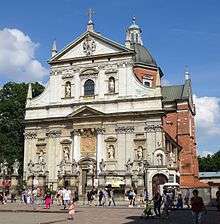
The Polish nobility of the Commonwealth had become excessively dominant, and its one exclusive idea was to remain in power. The lower and middle classes were often exploited and heavily taxed by wealthy or influential families of that era. This created a sense of fear among citizens of towns and villages that were privately owned by nobles. Sigismund, as the Head of State, always sought to restrict the privileges of the upper classes and decrease the nobility's influence over the parliament in order to personally gain control. This caused disdain for the monarch and many rebellions occurred during his reign. These revolts, however, were all crushed by Sigismund and the nobles eventually surrendered, having achieved little. Furthermore, one of Sigismund's desires was to be admired and idolized by his subjects; the unsuccessful rebellions were significant in strengthening his influence over the people and the country's politics. The Sejm (parliament), however, still was directly responsible for the majority of the Commonwealth's affairs, most notably declaring wars and suing for peace.
The King was unable to officially declare a war if the decision was not fully approved or supported by the Sejm and the Senate. The Polish Sejm usually consisted of around 600 nobles, diplomats and most influential politicians, who met annually at Warsaw or elsewhere, in order to contribute as little as possible to public needs and protest vehemently against everything they did not like or could not understand. The nobility was also in favour of absolute non-intervention in foreign affairs, as being the cheapest and least troublesome policy to pursue. The unwillingness with which the gentry of Poland parted with their money, especially for armaments was entirely due to the fear lest a popular monarch might curtail their privileges. Rather than run such a risk as this, they were ready to avoid every advantageous alliance, forgo every political opportunity, stint their armies, starve and abandon their generals, and even leave the territories of the Commonwealth unguarded and undefended. This was the case of Livonia, with its fine seaboard and its hundreds of towns and fortresses, which had temporarily fallen into the lap of Poland. It was later retaken by the Swedes due to poor organization of the army and disinterest of the nobles to finance any military actions or campaigns. The regular army, on the other hand, was very effective against enemy troops, especially in Polish-occupied Ukraine (Ruthenia) where it had an almost unlimited reserve of the best raw military material. Moreover the army was led by Zamoyski, Żółkiewski, Chodkiewicz and Stanisław Koniecpolski, four of the greatest generals and military commanders of the age.[10]
Brief conflict with England

The Muslim Ottoman Empire and Christian England were allies of convenience against Spain. While Elizabeth's armies were fighting Catholic forces in the Low Countries to prevent the Spanish from gaining secure harbours on the Channel coast to stage an invasion, England also served Turkish interests by diverting Spain from focusing on domination of the Mediterranean. In 1580, the Turks threatened to invade Poland from lands located north of the Black Sea. The good will of Poland was crucial to England because trade with countries bordering the Baltic was the source of grain and the all important forest products needed to maintain the navy. Furthermore, English merchants enjoyed preferential trading privileges within the borders of the Polish-Lithuanian Commonwealth. Elizabeth's intercession with the Caliphate was credited with cancelling the invasion and she received letters of praise from then reigning Polish king, Stephen Bathory.[11]
After Sigismund III was elected in 1587, Elizabeth's intelligence service gave notice that an ambassador was in transit and that the deputation was one of amity. On 23 July 1587, the Privy Council instructed the Lord Mayor of London to arrange housing for the diplomat, preferably with a merchant prominent in the Baltic trade. To ensure Elizabeth would not find fault with the preparations, the Lord Mayor was to report the arrangements made. Two days later a Polish envoy, Paweł Działyński, arrived at the palace in Greenwich. Brought to the reception hall, he found Elizabeth sitting on the throne under the canopy of state with all her nobles in attendance. The ambassador presented his credentials, and kissed the Queen's hand extended to him―a gesture of royal favour. Działyński then strode to the centre of the chamber without any forewarning of what he was about to say, and, instead of the oration of a legate that everyone anticipated, he couched in respectful words to flatter the monarch being addressed and spoke as a herald. In Latin, he hectored, admonished and criticized the queen, and declared an ultimatum of capitulation to terms or hostile action.[11]
Działyński informed Elizabeth that Sigismund was intending to marry a Catholic member of the Austrian royalty and was sympathetic to the Spanish Crown. The reason for his mission was to complain about Elizabeth's policy of having her navy capture ships of Polish and Hanseatic League merchants trading with Spain. This was intolerable to his sovereign. Hostilities would have commenced if Elizabeth had not rescinded her orders to interdict trade, release the captured ships, and restore the confiscated cargoes or make restitution.[11]
War against Sigismund in Sweden
Historical background
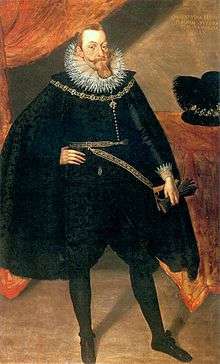
After Sigismund had been crowned King of Sweden 19 February 1594, he decided that no Parliaments (riksdagar) could be summoned without the King's consent. Despite this, Charles summoned a Parliament at Söderköping in autumn 1595, at which he managed to get his will through. The Duke was appointed Regent with "the advice of the Council", meaning that he was to govern Sweden together with the Privy Council during the King's absence from the Realm. Soon afterwards, the nobility of Finland, led by the Sigismund-appointed Governor, Klaus Fleming, rejected these decisions. They sympathised with the King and considered Charles a rebel. As a counterattack, Charles instigated a rebellion against Fleming, the Cudgel War, among the farmers in Ostrobothnia.[12]
Fleming managed to quell the revolt but died in April 1597. Roughly at the same time, a letter arrived from Sigismund's headquarters in Poland stating that he would not accept Charles as regent. The Duke then used a tactic which his father had employed, namely to resign from office. However, the response was not what Charles had been hoping for: the King accepted Charles's resignation and invested complete power in the Privy Council. Despite the difficult situation, Charles summoned another illegal Parliament the same year, this time in Arboga. Only one of the Privy Councillors showed up. The reason was that Charles's goal of deposing Sigismund had now been revealed, and the men understood that a serious revolt was brewing. When Duke Charles threatened the absent men with severe punishment some of them lost courage. Erik Gustavsson Stenbock, Arvid Gustavsson Stenbock, Erik Larsson Sparre, Erik Brahe and Sten Banér fled immediately to Sigismund.
Eruption of a civil war
Thus, in 1597, civil war erupted, and Duke Charles was able to assume control over a large share of the powerful castles in the country, and in this manner achieved control over almost all the Realm. The problem was Finland, where Klaus Fleming's widow guarded Åbo castle. But after psychological warfare, Charles and his followers managed to take the castle in Turku (Swedish: Åbo). It is said that when the Duke entered the castle chapel he saw Klaus Fleming's body lying in a coffin. He is said to have said: "Hadst thou now been alive, thy head would not have been in great safety." Then Fleming's widow Ebba Stenbock is said to have approached the Duke and responded: "If my late husband had been alive, Your Grace would never have entered herein."[13]
When Sigismund found out about what had happened in Finland he lost his patience. The King could not accept Duke Charles's disrespectful actions and decided to use force. This decision eventually would cost him the Swedish crown. In February 1598 Sigismund assembled an army consisting of merely 5,000 men, mostly Hungarian and German mercenaries. A larger army had been proposed, but had been dismissed since Sigismund expected Swedish forces to join him, and also did not want to come into conflict with them. The advisers and the King expected military support from Finland and Estonia (homes of the Swedish gentry formerly commanded by baron Klaus Fleming). They also wanted help from Denmark–Norway and pro-Sigismund parts of Sweden. The diplomat Laski was dispatched, but Denmark did not show any interest. In May, Sigismund's men started to advance northwards. The army gathered in Marienburg (Malbork), where the Livonian Jürgen Farensbach was appointed commander. The army was to be transported from Danzig (Gdańsk) to Sweden on Swedish ships, but the Swedish Estates declined. They refused to lend him ships as long as he stayed with a foreign army. There was widespread suspicion against Sigismund and his Catholic warriors. Thus the Estates promised to protect Duke Charles and the others who rebelled against the King.
Military actions and campaign
At the end of May 1598 Sigismund landed on Swedish soil at Avaskär. The King opened peacefully by sending the diplomat Samuel Łaski to Kalmar for negotiations. His task was to convince the city's commanders to open the gates. However, the negotiations led nowhere. Instead, the King took his soldiers and marched on Kalmar. The army halted just outside the city. The plan was to frighten the commanders into opening the gates. To make his message even more terrifying, Sigismund threatened the city with severe punishments and to withdraw the nobility of all children in the city. The propaganda worked well and Sigismund was able to make his long-desired entry on 1 August. After the fall of Kalmar, Duke Charles found himself with major trouble on his hands. The Polish Crown army attracted Swedish followers and Stockholm, lacking military defence, was easily taken with the help of the nobility and officers of Götaland. After this event, the cavalry of Uppland joined up, and new forces were mobilised in Finland and Estonia.[13]
The morning of 25 September 1598 the armies clashed in a major engagement at the Battle of Stångebro. Charles offered talks again but attacked in a mist while Sigismund's men were withdrawing to their camp, which resulted in only the mercenaries fighting since his Swedes refused to fight. Duke Charles won a decisive victory which forced Sigismund to agree to harsh terms. Charles demanded that the King send home his entire army, but that he himself was to stay and await a Parliament. Also, a number of Swedes who had sided with Sigismund, including his Council supporters, were captured. These were later executed in the Linköping Bloodbath of 1600. The peace agreement was sealed with a dinner between Charles and Sigismund on Linköping Castle. The King, who was under pressure, fearing for his life without his army and having realised that he had lost the political battle, fled during the coming days to Poland in late 1598. At the same time as the peace treaty was being signed in Linköping, conflicts were taking place in Dalarna. There, a pro-Sigismund bailiff, Jacob Näf, had tried to raise up the Dalecarlians against Duke Charles. Chaos ensued. Näf was executed, and the Dalecarlians set out on the so-called Neaf Campaign (1598), burning and killing down to Brunnbäck ferry. In Västergötland, Carl Carlsson Gyllenhielm, illegitimate son of Duke Charles, defeated the rebellion.
Aftermath and peace settlement
Sigismund was officially deposed from the throne of Sweden by a Parliament, Riksdag, held in Stockholm on 24 July 1599. He was given six months to say whether he wanted to send his son. Prince Władysław Vasa, to Sweden as his successor, under the condition that the boy would be brought up in the Evangelical faith. Otherwise the Estates would look for a new king. In February 1600, Duke Charles summoned the Estates of the Realm to Linköping. Since Sigismund had not provided a reply, the Estates elected Duke Charles as King Charles IX of Sweden. The consequences for those who had supported Sigismund were devastating. The most prominent among them were killed by the new King, in what was called the "Linköping Bloodbath". During the winter and spring of 1600, Charles also occupied the Swedish part of Estonia, as the castle commanders had shown sympathies towards Sigismund. Charles' invasion of Livonia led to a series of wars with Poland, starting with the Second Polish–Swedish War. Charles accepted the crown as Charles IX in 1604.[13]
Zebrzydowski Rebellion
The infamous Zebrzydowski's Rebellion or the Sandomierz Rebellion was a semi-legal rebellion against King Sigismund, formed on 5 August 1606 by Hetman Mikołaj Zebrzydowski, Jan Szczęsny Herburt, Stanisław Stadnicki, Aleksander Józef Lisowski and Janusz Radziwiłł in Stężyca and Lublin. It was primarily caused by the growing dissatisfaction with the King among the Polish nobility and wealthy magnates. In particular, the rebels disapproved of the King's efforts to limit the power of the nobles, his attempts to weaken the Sejm (the Polish parliament) and to introduce a hereditary monarchy in place of the elective one. The rebellion (1606–08) ended in the defeat of the rebels. Despite the failure to overthrow the King, the rebellion firmly established the dominance of the nobility over the monarch in the Polish political system.[14]
The Polish nobles gathered at the rebellion-formed a council and outlined their demands in 67 articles. They demanded Sigismund III's dethronement for breaching the Henrician Articles, and the expulsion of the Jesuits from the Polish–Lithuanian Commonwealth. They further demanded that the Sejm was appoint state officials instead of the king; that local officials should be elected and not appointed and that Protestant's rights should be expanded and protected. The 1607 Parliament sitting rejected the demands. Meanwhile, the rebel nobles gathered in the town of Guzów. In 1607 the Polish Royal Army, led by Hetman Jan Karol Chodkiewicz was sent to pacify the rebels. A full-scale battle ensued on 5 July, with 200 casualties, which resulted in the victory of the Royalist forces. By 1609, the rebellion was over. Two years after the start of the revolt, the rebellious nobles formally surrendered to the king at the 1609 meeting of the Sejm, which became known as the Pacification Sejm. In return for their surrender the rebels were granted leniency. Many royal supporters, including Hetman Chodkiewicz, had successfully argued for amnesty for the rebels. Despite the failure of the rebellion, it nevertheless ruined any chance that Sigismund III had to strengthen his role in the government.[14]
After the rebellion, King Sigismund attempted to funnel the nobles' restless energy into external wars. This, combined with other factors, led to the official Commonwealth involvement in the Polish-Muscovite War (1609–1618), which followed the Dimitriads (1605–1609).[14]
The first rebellion in Polish history had sinister consequences. Royalty lost, to great extent, the moral prestige it had enjoyed... The Polish constitution was henceforth regarded as sacrosanct and the king had to renounce not only the idea of making any far-reaching changes in it, but even any reform.
Piotr Skarga and Sigismund, "King of the Jesuits"
The election of Sigismund III to the throne proved to be the greatest blow it was possible to inflict upon Protestanism in Poland. Brought up by his mother, Catherine Jagiellon, in the strictest Roman Catholic doctrines, he made the promotion of the interests of Rome the guiding motive of all his actions. This zeal for Rome outweighed all considerations of prudence or policy; through it he lost two hereditary thrones, and brought innumerable calamities on the country which election had handed over to him, "In order to make sure of heaven", said the Emperor Ferdinand, "he has renounced earth". The Protestants called him the "King of the Jesuits", and Sigismund gloried in the appellation. This feeble imitation of Philip II of Spain possessed all the bigotry and zeal of his model without his abilities or strength of character. In all that he did he was ruled by the Jesuits; he bestowed honours only on those whom they favoured, and preferred their advice to that of his wisest counselors. By private interviews, wrote a Roman Catholic historian who was also bishop of Przemyśl, which they could always command, the Jesuits so bound the king by their solicitations, that he did everything according to their counsel, and the hopes and cares of courtiers had no weight except by their favour. Chief among these advisers of the king was Piotr Skarga, one of the most eminent of Polish Jesuits. Born in Mazovia in 1536, he was educated at the Jagiellonian University, where he distinguished himself by winning the prima Laurea. He then proceeded to Rome, where he entered the society in 1568. He began his preaching at Pułtusk, and visited the colleges which Stephen Bathory had founded at Riga, Dorpat and Połock; his eloquence was very successful, and even now his sermons are thought highly of in Poland. On the accession of Sigismund he became royal chaplain and he founded a confraternity of St. Lazarus at Warsaw, and many other establishments elsewhere in the country.[15]
Relationship with the Mennonites
Sigismund confirmed the contracts of lease made with the Mennonites and on 20 October 1623, accorded special privileges to the lace-makers originating from Scotland, most of whom were Mennonites. But he refused to grant them any new rights or liberties. Upon the complaint of the city council of Elbing (Elbląg) that the Mennonites broke up marriages without having previously informed the authorities, married one another, and divided property at their pleasure, he forbade the Mennonites, upon penalty of a fine of 100 guilders, to marry without the foreknowledge of the authorities, and ordered that the Mennonites should be given no special rights. When the Mennonites nevertheless requested release from all civil handicaps, especially from military defense of the city and the court oath, he decreed on 26 April 1615, that they should do their duty like others. But the ruling was not enforced. On 26 April 1626, the king sent the following orders to the magistrate of Elbing, because he had heard that they had accepted Anabaptists and Mennonites and given them liberties, so that they, without swearing to him and the city, carried on trade and crafts, bought properties and food from the citizens, and tolerated them free of all that citizens must assume, and, what was not the least, their testimony at court was counted as valid as an oath, all of which is contrary to the public and special laws and offended his royal regard sorely and threatened to do harm, therefore these people were held to sworn obligations to the king and the city, to take up all civil burdens.[16] Sigismund placed wild hordes of Poles and German mercenaries at the disposal of his brother-in-law, Ferdinand II of Austria, which burned and sacked the Hutterite villages at Schädowitz, Watznobis, and Goding, killing thousands.[16]
Assassination attempt in Warsaw
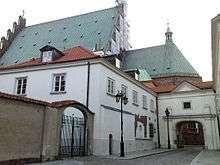
An unsuccessful attempt on the life of the king was made on 15 November 1620. It occurred on Sunday, at 9 am, when the monarch was to attend Mass in St. John's Archcathedral in Warsaw. Sigismund was to arrive by walking on a wooden bridge-looking construction that connected the Royal Castle with the temple. When the royal procession already reached the end of the bridge, hidden in a nearby window was nobleman Michał Piekarski. The assassin previously killed a Hungarian mercenary that was protecting the post. When the monarch reached the final steps, Piekarski instantly jumped out and threw himself on the king, stabbing him twice, firstly in the back and then in the cheek, another hit was in the arm, however, the assassin was not able to cause any deadly harm because of the royal guards that were initially standing to the right of the king and Piekarski attacked from the left. Shortly after this, Sigismund fell flat on the ground, pale and lifeless, and from the church Priest Kobierzycki started to groan and shout – he has seen the attack from the temple's stained glass window or from the belfry. A group of local civilians and citizens surrounded the procession, the king quickly fainted and his clothes were stained in blood, however, the guards were able to revive the monarch. Eventually after medical examinations the wounds proved to be harmless.[17] Few minutes later, panic erupted in the crowd and the air filled with the atmosphere of terror. Most of the people gathered in the church, that have arrived before the royal procession, believed that the king was already dead. Initially it was thought that the capital was invaded by the Muslim Tatars or, at least, by their spies.[17]
The circumstances of this attack and the assassin were known exceptionally well after the attempt, as soon pamphlets appeared on the Market Square, reporting three different viewpoints on the subject, published in a total of five editions. The assassin was indeed Michał Piekarski, always regarded by the society as a freak, a melancholic, unrestrained in deeds (as a child he suffered head and brain damage – this may have been the cause of his mental illness). Earlier, he murdered the royal cook and killed, and wounded several people from the royal court. Piekarski, after hearing the news of the successful assassination of Henry IV in Paris (1610), decided to assassinate Sigismund, simply for fame. For the appropriate moment he waited patiently for 10 years. At trial he did not deny the crime he committed and heavily insulted both the jury, the Court Marshal and the monarch. He was executed in exactly the same way as François Ravaillac (the killer of the French king) on 26 November 1620 in Warsaw, in a torture area called Piekiełko (Devil's den or Devil's place).[17]
Thirty Years' War
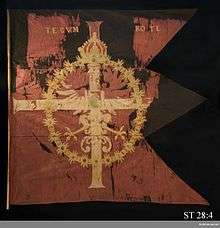
Sigismund III would have intervened in the Thirty Years' War, on the Catholic side, but for the determined opposition of the Parliament (Sejm), expressing itself in fresh insurrections and the refusal of supplies. His intervention would have taken the form of an invasion and, possibly, an occupation of Transylvania, which, under the energetic and ambitious Princes of the Protestant Houses of Bethlen and Rakoczy was the active ally of the Sultan and equally dangerous to Habsburg Austria and Poland. This would result in a war that would devastate the eastern borderlands of the Polish–Lithuanian Commonwealth, known as the Kresy, and Sigismund was aware that he would not stand a chance against the mighty Sultan and the entire, great Ottoman Empire stretching from the Middle East all the way to the Balkans. The best heads in Poland, including Hetman Stanisław Żółkiewski, warmly approved of the King's policy in this respect, but it proved to be impracticable. The Parliament's mania for non-intervention went so far that it refused to grant any subsidies for the Swedish War with the disastrous consequences already recorded. Sigismund eventually decided that joining the Thirty Years' War would diminish the country's national prestige and power in the region. This, however, weakened the alliance between the Habsburg states and the Polish–Lithuanian Commonwealth.[10]
Religious issues, decline and death
Throughout these wars King Sigismund tried to stabilize and streamline the Commonwealth government. The electoral monarchy in Poland had created a nobility with rather too extensive powers and a great deal of division. Sigismund worked to gain more power for the king as well as to allow government business to pass with a majority of votes of the parliament rather than unanimity which was extremely hard to achieve and meant that things often did not get done. All these actions led to a rebellion but the King was ultimately victorious and despite what his many detractors might say his reign marked a period of Polish greatness the likes of which has not often been seen. He made the Commonwealth very much the dominant power of Central and Eastern Europe and just as importantly ensured that Poland remained a solidly Catholic country in the face of Protestant incursions. He was considered a brave man, a talented monarch and something of a Renaissance man as is evidenced by his devout faith and his artistic talent. If the reforms he planned were successful and if he would create a personal union with Poland's neighbours, Sigismund might have been the father of a Catholic dynasty that stretched across Poland, Sweden, Finland, Lithuania, Moldavia, Turkey and Russia. It did not happen, but that should not detract from his greatness as one of the royal champions of the Catholic Reformation period. Sigismund was a gifted artist, painter and goldsmith; only one of his three paintings survived, one was for centuries erroneously attributed to Tintoretto; and from his own, personal workshop came the main part of the famous silver coffin of St. Adalbert of Prague at the Cathedral in Gniezno.[18] Moreover, Sigismund was deeply interested in alchemy and ancient methods of turning metals into gold; he often cooperated with the famous alchemist and philosopher Michael Sendivogius (Polish: Michał Sędziwój).
Towards the end of his reign, Sigismund III withdrew altogether from politics and devoted himself exclusively to family matters and his interests in performing arts. Shortly after the sudden death of his second wife, Constance of Austria, Sigismund fell dangerously ill and experienced severe mental and psychological problems. He died of a stroke on 30 April 1632 at the age of 65 in the Royal Castle in Warsaw and was interred inside Wawel Cathedral in Kraków. He was succeeded by his son, King Władysław IV.[16]
Opinion of reign and legacy
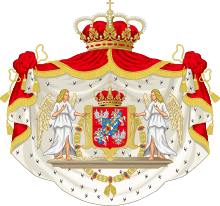
The reign of King Sigismund III of Poland is often spoken of as the beginning of the end of Polish greatness. In terms of worldly success he certainly met with many defeats and setbacks. Yet, he was also one of the great Catholic champions of Europe and his reign can also be seen as one of many opportunities for an even greater Poland. He was stubborn, but a man of principle who would follow the hard but upright path rather than compromise his values for a more sure chance at success. As a monarch who reigned during the Catholic Reformation (also called the counter-reformation) he constantly worked to see the restoration of all of his subjects to the true faith embodied in the Church of Rome headed by the Pope of the Roman Catholic Church. Oddly enough for such a staunchly Catholic monarch his story begins in the staunchly Protestant Kingdom of Sweden. Sigismund's rule is often criticized in Poland for his unsuccessful decisions that negatively affected the diplomatic and financial situation of the country, however, especially by the nationalists, he is widely praised for conquering the eastern empires and gaining territories for the Polish–Lithuanian Commonwealth, thus creating the largest country in Europe of the 16th and 17th century that lasted until the final partition in 1795.
Sigismund III Vasa is one of the personages in a famous painting by Jan Matejko, depicting the preaching of Piotr Skarga.
Royal titles
- Royal titles in Latin: Sigismundus Tertius Dei gratia rex Poloniæ, magnus dux Lithuaniæ, Russiæ, Prussiæ, Masoviæ, Samogitiæ, Livoniæque, necnon Suecorum, Gothorum Vandalorumque hæreditarius rex.
- English translation: Sigismund III, by the grace of God, king of Poland, grand duke of Lithuania, Ruthenia, Prussia, Masovia, Samogitia, Livonia, and also hereditary king of the Swedes, Goths and Vandals.
Sigismund was elected King of Poland and reigned 1587–1632. By paternal inheritance, he also succeeded in 1592 as King of Sweden but was deposed in 1599. His successor, Charles IX of Sweden, officially gained the Swedish throne in 1604. From his grandmother Bona Sforza he inherited the title of King of Jerusalem.
Gallery
 Equestrian portrait of king Sigismund III Vasa by Peter Paul Rubens.
Equestrian portrait of king Sigismund III Vasa by Peter Paul Rubens. Portrait of Sigismund III Vasa, ca. 1590.
Portrait of Sigismund III Vasa, ca. 1590.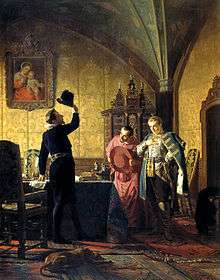 False Dmitriy I takes an oath of allegiance to Sigismund III, by Nikolai Nevrev (1874).
False Dmitriy I takes an oath of allegiance to Sigismund III, by Nikolai Nevrev (1874). Statue of King Sigismund III on top of Sigismund's Column in Warsaw.
Statue of King Sigismund III on top of Sigismund's Column in Warsaw..jpg) Portrait by court painter Martin Kober.
Portrait by court painter Martin Kober.- Gold coin featuring Sigismund, 1611.
 Sigismund III on catafalque following his death.
Sigismund III on catafalque following his death.
Personal life
Ancestry
| Ancestors of Sigismund III Vasa | ||||||||||||||||||||||||||||||||||||||||||||||||||||||||||||||||||||||||||||||||||||||||||||||||||||||||||||||||||||||||||||||||||||||||||||||||||||||||||||||||||||||||||||||||||||||||||||||||||||||||||||||||||||||||||||||||||||||||||||||||||||||||||||||||||||||||||||||||||||||||||||||||||||||||||||||||||||||||||||||||||||||||||||||||||||||||||||||||||||||||||||||||||||||||||||||||||||||||||||||||||||||||||||||||||||||||||||||||||||||||||||||||||||||||||||||||||||||||||||||||||||||||||||||||||||||||||||||||||
|---|---|---|---|---|---|---|---|---|---|---|---|---|---|---|---|---|---|---|---|---|---|---|---|---|---|---|---|---|---|---|---|---|---|---|---|---|---|---|---|---|---|---|---|---|---|---|---|---|---|---|---|---|---|---|---|---|---|---|---|---|---|---|---|---|---|---|---|---|---|---|---|---|---|---|---|---|---|---|---|---|---|---|---|---|---|---|---|---|---|---|---|---|---|---|---|---|---|---|---|---|---|---|---|---|---|---|---|---|---|---|---|---|---|---|---|---|---|---|---|---|---|---|---|---|---|---|---|---|---|---|---|---|---|---|---|---|---|---|---|---|---|---|---|---|---|---|---|---|---|---|---|---|---|---|---|---|---|---|---|---|---|---|---|---|---|---|---|---|---|---|---|---|---|---|---|---|---|---|---|---|---|---|---|---|---|---|---|---|---|---|---|---|---|---|---|---|---|---|---|---|---|---|---|---|---|---|---|---|---|---|---|---|---|---|---|---|---|---|---|---|---|---|---|---|---|---|---|---|---|---|---|---|---|---|---|---|---|---|---|---|---|---|---|---|---|---|---|---|---|---|---|---|---|---|---|---|---|---|---|---|---|---|---|---|---|---|---|---|---|---|---|---|---|---|---|---|---|---|---|---|---|---|---|---|---|---|---|---|---|---|---|---|---|---|---|---|---|---|---|---|---|---|---|---|---|---|---|---|---|---|---|---|---|---|---|---|---|---|---|---|---|---|---|---|---|---|---|---|---|---|---|---|---|---|---|---|---|---|---|---|---|---|---|---|---|---|---|---|---|---|---|---|---|---|---|---|---|---|---|---|---|---|---|---|---|---|---|---|---|---|---|---|---|---|---|---|---|---|---|---|---|---|---|---|---|---|---|---|---|---|---|---|---|---|---|---|---|---|---|---|---|---|---|---|---|---|---|---|---|---|---|---|---|---|---|---|---|---|---|---|---|---|---|---|---|---|---|---|---|---|---|---|---|---|---|---|---|---|---|---|---|---|---|---|---|---|---|---|---|---|---|---|---|---|---|---|---|---|---|---|---|---|---|---|---|---|---|---|---|---|---|---|---|---|---|---|---|---|---|---|---|---|---|---|---|---|---|---|---|---|---|---|---|---|---|---|---|---|---|---|---|---|---|---|---|---|---|---|---|---|---|---|---|---|
| ||||||||||||||||||||||||||||||||||||||||||||||||||||||||||||||||||||||||||||||||||||||||||||||||||||||||||||||||||||||||||||||||||||||||||||||||||||||||||||||||||||||||||||||||||||||||||||||||||||||||||||||||||||||||||||||||||||||||||||||||||||||||||||||||||||||||||||||||||||||||||||||||||||||||||||||||||||||||||||||||||||||||||||||||||||||||||||||||||||||||||||||||||||||||||||||||||||||||||||||||||||||||||||||||||||||||||||||||||||||||||||||||||||||||||||||||||||||||||||||||||||||||||||||||||||||||||||||||||
Marriages and descendants
Sigismund married twice. Firstly, on 31 May 1592, to Anna of Austria (1573–1598), daughter of Archduke Charles II of Austria (1540–1590) and his wife Maria Anna of Bavaria (1551–1608). They had five children:
- Anne Marie (Polish: Anna Maria; 23 May 1593 – 9 February 1600)
- Catherine (Polish: Katarzyna; 9 May 1594 – 5 June 1594)
- Vladislaus (Polish: Władysław; 9 June 1595 – 20 May 1648), reigned 1632–1648 as Władysław IV Vasa of Poland
- Catherine (Polish: Katarzyna; 27 September 1596 – 11 June 1597)
- Christopher (Polish: Krzysztof; 10 February 1598)
And secondly, on 11 December 1605, to his first wife's sister, Constance of Austria (1588–1631). They had seven children:
- John Casimir (Polish: Jan Kazimierz; 25 December 1607 – 14 January 1608)
- John Casimir (Polish: Jan Kazimierz; 22 May 1609 – 1672), reigned 1648–1668 as John II Casimir Vasa of Poland
- John Albert (Polish: Jan Albert/Olbracht; 25 May 1612 – 22 December 1634)
- Charles Ferdinand (Polish: Karol Ferdynand; 13 October 1613 – 9 May 1655)
- Alexander Charles (Polish: Aleksander Karol; 4 November 1614 – 19 November 1634)
- Anna Constance (Polish: Anna Konstancja; 26 January 1616 – 24 May 1616)
- Anna Catherine Constance (Polish: Anna Katarzyna Konstancja; 7 August 1619 – 8 October 1651) was the first wife of Philip William, Elector Palatine.
See also
| Wikimedia Commons has media related to Sigismund III of Poland. |
- List of Swedish monarchs
- History of Poland (1569–1795)
- History of Sweden
- Foundation of modern Sweden
- Unions of Sweden
- Sigismund's Column
- Urszula Meyerin – mistress of Sigismund III
References
Bibliography
- Frost, R. I., 2000, The Northern Wars, 1558–1721, Harlow: Pearson Education Limited, ISBN 9780582064294
- Jolanta Talbierska, Grafika XVII wieku w Polsce. Funkcje, ośrodki, artyści, dzieła, Warsaw 2011, p. 32
- Stanisław Rosik, Przemysław Wiszewski, Wielki Poczet polskich królów i książąt, Wrocław 2006, p. 923.
- Janusz Tazbir: Historia kościoła katolickiego w Polsce 1460–1795. Warsaw: 1966, p. 91.
- Stanisław Rosik, Przemysław Wiszewski: Poczet polskich królów i książąt. p. 927.
- Warszawa w latach 1526–1795, Warsaw 1984 ISBN 83-01-03323-1, p. 13.
- Stanisław Rosik, Przemysław Wiszewski, Poczet polskich królów i książąt, p. 929.
Inline citations
- 1 2 "Sigismund III Vasa". Retrieved 30 October 2016.
- ↑ "Sigismund III Vasa - king of Poland and Sweden". Retrieved 30 October 2016.
- ↑ pisze, Przemek (3 July 2013). "Bitwa pod Byczyną. Zamoyski upokarza Habsburgów i gwarantuje tron Zygmuntowi III - HISTORIA.org.pl - historia, kultura, muzea, matura, rekonstrukcje i recenzje historyczne". Retrieved 16 November 2016.
- ↑ "Bitwa pod Byczyną była ważniejsza od słynnej bitwy pod Wiedniem". 19 February 2016. Retrieved 16 November 2016.
- ↑ "Koronacja Zygmunta III Wazy na króla Szwecji - Muzeum Historii Polski". Retrieved 16 November 2016.
- ↑ Siarczyński, Franciszek (1 January 1828). "Obraz wieku panowania Zygmunta III. Króla Polskiego i Szwedzkiego: zawieraiący opis osób żyiących pod jego panowaniem, znamienitych przez swe czyny pokoiu i woyny, cnoty lub występki dzieła piśmienne, zasługi użyteczne i cele sztuki". Retrieved 16 November 2016 – via Google Books.
- ↑ http://www.merriam-webster.com/concise/sigismund%20iii%20vasa
- 1 2 Cuhaj, George S., ed. (2009). Standard Catalog of World Gold Coins 1601–Present (6 ed.). Krause. p. 996. ISBN 978-1-4402-0424-1.
- ↑ http://encyclopedia2.thefreedictionary.com/Sigismund+III
- 1 2 3 4 5 "Polish and Russian Political History – Sigismund III And The Republic, 1588-1632". Retrieved 30 October 2016.
- 1 2 3 http://triggs.djvu.org/global-language.com/enfolded/SHIFF/CorambisPoloniusDraft15.pdf
- ↑ Frost, R.I., 2000, The Northern Wars, 1558–1721, Harlow: Pearson education Limited, ISBN 9780582064294
- 1 2 3 Frost, R.I., 2000, The Northern Wars, 1558–1721, Harlow: Pearson Education Limited, ISBN 9780582064294
- 1 2 3 http://sussle.org/t/Zebrzydowski_Rebellion
- ↑ Fromm, Joseph (11 July 2010). "Good Jesuit, Bad Jesuit: Sigismund III "King Of The Jesuits"". Retrieved 30 October 2016.
- 1 2 3 "Sigismund III Vasa, King of Poland (1566-1632) - GAMEO". Retrieved 30 October 2016.
- 1 2 3 "Zamach na króla Zygmunta III Wazę". Retrieved 30 October 2016.
- ↑ Jolanta Talbierska, Grafika XVII wieku w Polsce. Funkcje, ośrodki, artyści, dzieła, Warszawa 2011, s. 32
| Sigismund III Vasa Born: 20 June 1566 Died: 30 April 1632 | ||
| Regnal titles | ||
|---|---|---|
| Vacant Title last held by Anna and Stephen |
King of Poland Grand Duke of Lithuania 1587–1632 |
Vacant Title next held by Władysław IV |
| Preceded by John III |
King of Sweden 1592–1599 |
Vacant Title next held by Charles IX |

